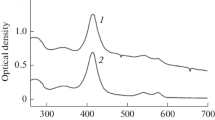Summary
Phallolysin from the toadstool, Amanita phalloides, is a basic protein that causes direct haemolysis of red cells. The dose-response curve is steep; the pH optimum is in the weakly acid range. The rate of haemolysis increases with the concentration of the lysin, the optimal temperature is 20°C. The percentage haemolysis-time curves are S-shaped. Haemolysis is of the non-osmotic type. Ca2+ is not required but inhibits haemolysis in a concentration-dependent fashion, as do Mg2+ and Zn2+. The red cell sensitivity of various animal species decreases in the following sequence: mouse > rabbit=guinea pig > rat > man > dog ≃ pig > sheep-cattle. Red cells of cattle and sheep are largely resistant. Phallolysin is virtually not consumed on haemolysis: the amount of haemoglobin released increases with the number of red cells applied; on repeated addition of fresh red cells the haemolysate retains its full activity. Phallolysin is not inhibited by serum, albumin, cholesterol, lecithin, cephalin or sphingomyelin; inhibition by red cell ghosts of phallolysin haemolysis is considerably less than that of digitonin haemolysis. At sublytic concentrations phallolysin, unlike benzalkonium chloride, liberates practically no membrane lipids from human red cells. Surface activity of phallolysin does not exceed that of bovine serum albumin—A saponin-like interaction with cholesterol as the basic mechanism of haemolysis can be disregarded. There is also no evidence suggesting a detergent-like effect.
Similar content being viewed by others
References
Bernheimer, A. W.: Kinetics of lysis by Clostridium septicum hemolysin. J. exp. Med. 80, 333–339 (1944)
Bernheimer, A. W.: Cytolytic toxins of bacterial origin. Science 159, 847–851 (1968)
Bligh, E. G., Dyer, W. J.: A rapid method of total lipid extraction and purification. Canad. J. Biochem. Physiol. 37, 912–917 (1959)
Cho, K. S., Proulx, P.: Studies on the mechanism of hemolysis by acyl carnitines, lysolecithines and acyl cholines. Biochim. biophys. Acta (Amst.) 225, 214–223 (1971)
Collier, B.: Factors affecting the hemolytic action of “lysolecithin” upon rabbit erythrocytes. J. gen. Physiol. 35, 617–628 (1952)
Cooper, L. Z., Madoff, M. A., Weinstein, L.: Hemolysis of rabbit erythrocytes by purified staphylococcal alpha-toxin. J. Bact. 87, 127–135 (1964)
Delezenne, C., Fourneau, E.: Constitution du phosphatide hémolysant (lysocithine) provenant de l'action du venin de cobra sur le vitellus de l'oeuf de poule. Bull. Soc. chim. Fr. 15, 421–434 (1914)
Dodge, J. T., Mitchell, C., Hanahan, D.: The preparation and chemical characteristics of hemoglobin-free ghosts of human erythrocytes. Arch. Biochem. Biophys. 100, 119–130 (1963)
Du Noüy, P. L.: An interfacial tensiometer for universal use. J. gen. Physiol. 7, 625–631 (1925)
Faulstich H., Weckauf, M.: Cytolysis of red cells mediated by phallolysin, a toxin binding to N-acetylglucosamine on the cell surface. Hoppe-Seylers. Z. physiol. Chem. 356, 1187–1189 (1975)
Grosse, A., Tauböck, K.: Lysocithin als Rheumamittel. Z. Rheumaforsch 5, 429–445 (1942)
Habermann, E.: Über die Wirkung tierischer Gifte auf Erythrocyten. Z. ges. exp. Med. 129, 436–464 (1958)
Habermann, E.: Biochemie, Pharmakologie und Toxikologie der Inhaltsstoffe von Hymenopterengiften. Ergebn. Physiol. 60, 220–325 (1968)
Halbert, S. P.: Streptolysin O. In: Microbial toxins. Vol. III. Bacterial protein toxins (Montie, Th. C., Kadis, S., Ajl, S. L., ed.), pp. 69–98. New York: Academic Press 1970
Keen, T. E. B., Crone, H. D.: The hemolytic properties of extracts of tentacles from the cnidarian Chironex fleckeri. Toxicon 7, 55–63 (1969)
Klibansky, Ch., Condrea, E., De Vries, A.: Changes in plasma phospholipids after intravenous phosphatidase A injection in the rabbit. Amer. J. Physiol. 303, 114–118 (1962)
Kondo, T., Tomizawa, M.: Hemolytic action of surface-active electrolytes. J. Colloid Sci. 21, 224–228 (1966)
Kondo, T., Tomizawa, M.: Release of lipids from red cell membrane by surface-active agents. Chem. Pharm. Bull. 16, 738–740 (1968)
Kondo, T., Tomizawa, M.: Mechanism of hemolysis by cationic surface-active agents. J. pharm. Sci. 58, 1378–1381 (1969)
Lominski, I., Arbuthnott, J. P.: Some characteristics of staphylococcus alpha haemolysin. J. Path. Bact. 83, 515–520 (1962)
Marucci, A.: Mechanism of action of staphylococcal alpha-hemolysin. I. Some factors influencing the measurement of alphahemolysin. J. Bact. 86, 1182–1188 (1963)
Neeb, G.: Untersuchungen zur Frage einer Phospholipaseaktivität von Phallolysin. Zahnmed. Diss., Würzburg 1973
Odenthal, K. P., Seeger, R., Vogel, G.: Toxic effects of phallolysin from Amanita phalloides. Naunyn-Schmiedeberg's Arch. Pharmacol. 290, 133–143 (1975)
Ponder, E.: Hemolysis and related phenomena, p. 186 ff. New York: Grune & Stratton 1948
Ransom, F.: Saponin und sein Gegengift. Dtsch. med. Wschr. 27, 194–196 (1901)
Rideal, E., Taylor, F. H.: On haemolysis by anionic detergents. Proc. roy. Soc. B 146, 225–241 (1957)
Scharrer, H.: Nachweis, Reinigung und Charakterisierung eines hämolytisch wirkenden Toxins aus Amanita phalloides. Med. Diss., Würzburg 1971
Seeger, R.: Nachweis, Isolierung und Charakterisierung von Phallolysin, einem toxischen, hämolytisch wirkenden Protein aus Amanita phalloides. Habilitationsschrift, Würzburg 1972
Seeger, R.: Phallolysin, ein hochmolekulares Toxin aus Amanita phalloides. Experientia (Basel) 29, 829 (1973)
Seeger, R.: Demonstration and isolation of phallolysin, a haemolytic toxin from Amanita phalloides. Naunyn-Schmiedeberg's Arch. Pharmacol. 287, 277–287 (1975a)
Seeger, R.: Some physico-chemical properties of phallolysin obtained from Amanita phalloides. Naunyn-Schmiedeberg's Arch. Pharmacol. 288, 155–162 (1975b)
Stahl, E.: Dünnschichtchromatographie, 2. Aufl. Berlin-Heidelberg-New York: Springer 1967
Wright, M. R.: Effect of pH on the haemolysis of rabbit erythrocytes by staphylococcus alpha-toxin. J. med. Microbiol 2, 301–308 (1969)
Author information
Authors and Affiliations
Additional information
with the technical assistance of MELITTA HAUPT and LUISE FEULNER
Supported by a grant from the Deutsche Forschungsgemeinschaft.
Rights and permissions
About this article
Cite this article
Seeger, R., Burkhardt, M. The haemolytic effect of phallolysin. Naunyn-Schmiedeberg's Arch. Pharmacol. 293, 163–170 (1976). https://doi.org/10.1007/BF00499222
Received:
Accepted:
Issue Date:
DOI: https://doi.org/10.1007/BF00499222




